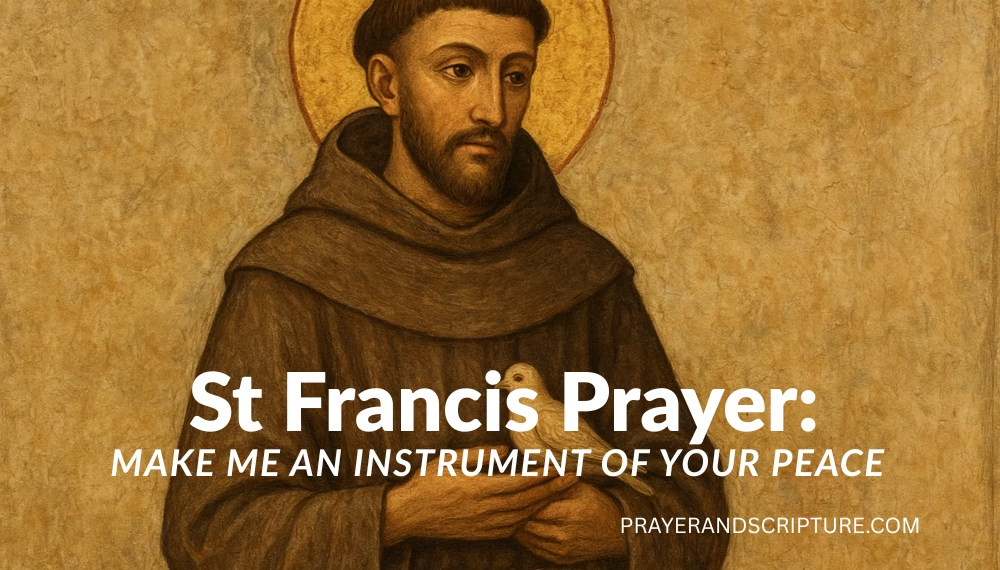Few prayers have crossed as many cultural, denominational, and generational boundaries as the St Francis Prayer: Make Me An Instrument Of Your Peace. For more than a century, these words have been whispered in private devotion, sung in churches, spoken at state ceremonies, and recited at funerals and peace gatherings. The prayer is short enough to memorize yet deep enough to challenge the human heart for a lifetime. It calls us not just to seek peace, but to become peace—to be the very channel through which God’s love and reconciliation flow to a hurting world.
In an age filled with division, misunderstanding, and unrest, the St Francis Prayer continues to speak a timeless truth: lasting change begins within the human heart. The beauty of this prayer lies in its call to reverse the natural instincts of self-centeredness and instead live a life of compassion, forgiveness, and humble service.

St Francis Prayer: Make Me An Instrument Of Your Peace
Have you ever stumbled upon a piece of writing that just stops you in your tracks, making you pause and reflect on what really matters in life? That’s exactly what the St. Francis Prayer does for so many people. Often called “Make Me an Instrument of Your Peace,” this beautiful invocation has touched hearts across generations, religions, and cultures. It’s a call to humility, service, and inner transformation—a reminder that true peace starts from within and radiates outward.
Whether you’re seeking spiritual guidance, emotional solace, or just a moment of quiet inspiration, this prayer offers profound wisdom in simple words. In this deep insight, we’ll explore its words, unpack its layered meanings, trace its surprising history, and discover how it continues to inspire real change in people’s lives. We’ll also look at practical ways to weave it into your everyday routine and examine its various adaptations over time. By the end, I hope you’ll feel equipped not just to recite it, but to live it. Let’s journey together into the heart of this timeless gem.
The Surprising Origin of the St. Francis Prayer
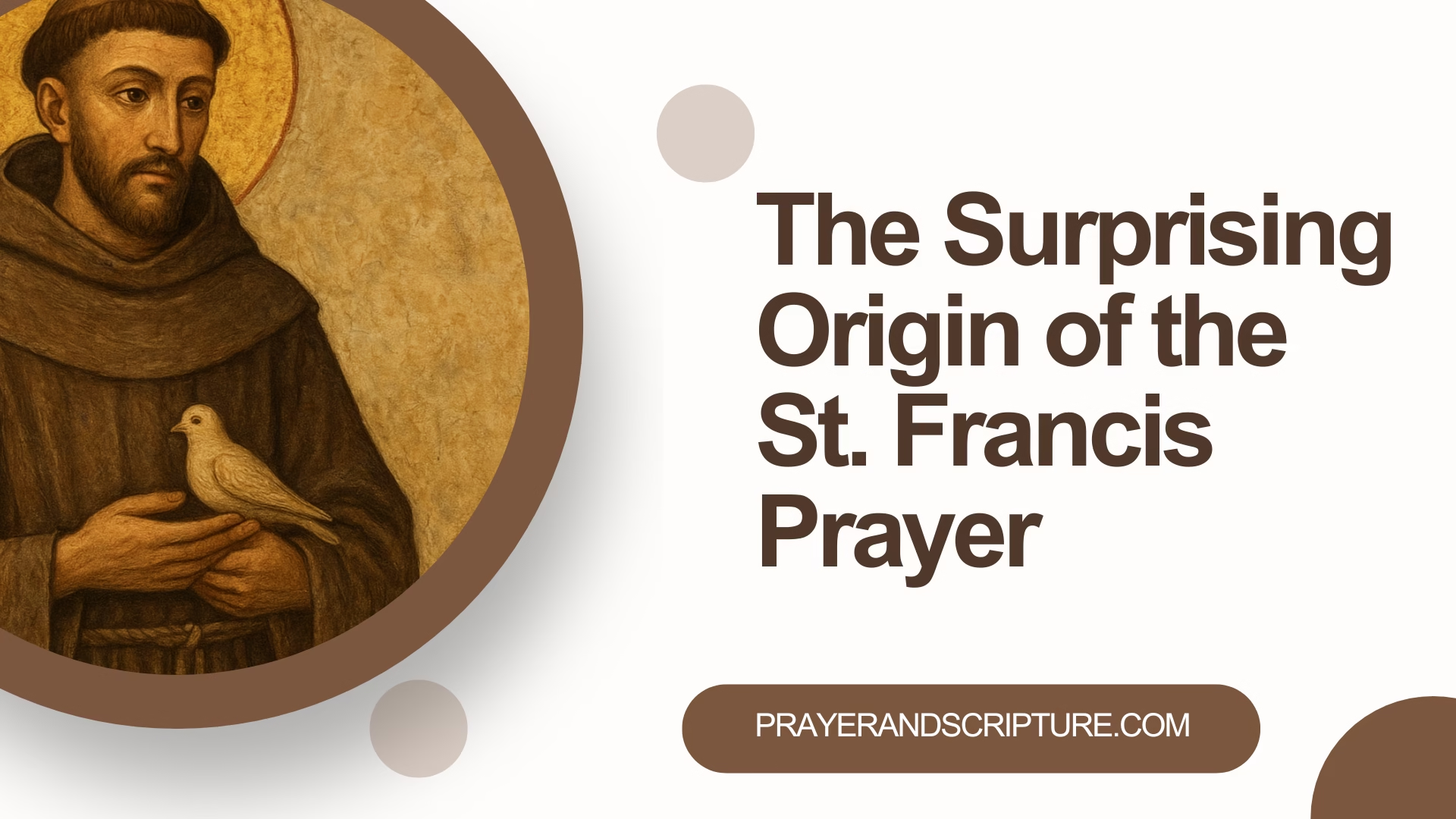
One of the most fascinating facts about this beloved prayer is that St. Francis of Assisi did not actually write it. Historical research shows it first appeared in 1912 in a small French Catholic publication called La Clochette (“The Little Bell”). It was printed anonymously, with no mention of St. Francis. Six years later, during the devastation of World War I, the prayer was circulated widely on cards and pamphlets, often with a picture of St. Francis on the front. Over time, people assumed he was the author.
The misattribution stuck because the spirit of the prayer so closely reflects the values of St. Francis—his commitment to peace, humility, forgiveness, and unconditional love. Whether or not he penned the words, the prayer embodies his way of life. This blending of historical fact and spiritual association has given the prayer a unique place in Christian tradition, standing as a modern expression of Franciscan values that transcend time and culture.
The Full Words of the St Francis Prayer
At its core, the St. Francis Prayer is a poetic plea for divine assistance in becoming a vessel of goodness in a chaotic world. Here’s the complete text, often recited in churches, meditation sessions, or personal quiet times:
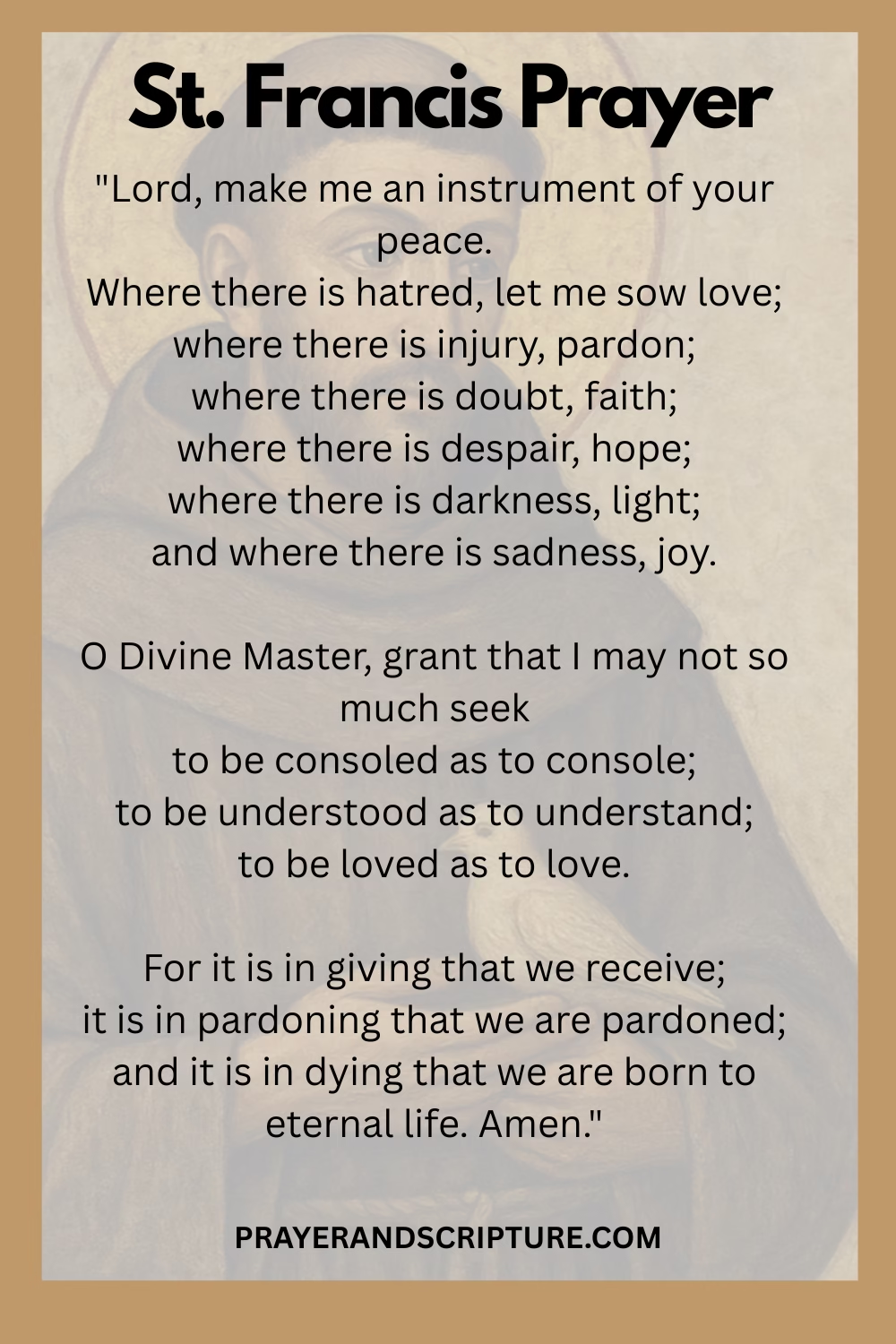
These lines flow like a gentle stream, building from active sowing of virtues to a profound acceptance of selflessness, and culminating in paradoxical truths about life and death. Reading it aloud, you might feel a sense of calm wash over you—it’s designed that way, with rhythmic repetition and balanced contrasts that mirror the ups and downs of human experience.
Many people memorize it easily because of its structure: the first stanza focuses on transforming negative situations, the second on shifting personal desires, and the final lines reveal the spiritual rewards. In a fast-paced world filled with division and stress, these words serve as an anchor, reminding us that peace isn’t passive; it’s something we actively create.
I’ve found myself whispering parts of it during tough days, like when dealing with a heated argument or feeling overwhelmed by global news. It’s not just poetry—it’s a blueprint for compassionate living. Over the years, this prayer has been printed on cards, set to music, and even tattooed on skin, proving its enduring appeal. But to truly appreciate its power, we need to dig into where it came from and why it’s so often linked to one of history’s most beloved saints.
Uncovering the Historical Origins of the St. Francis Prayer
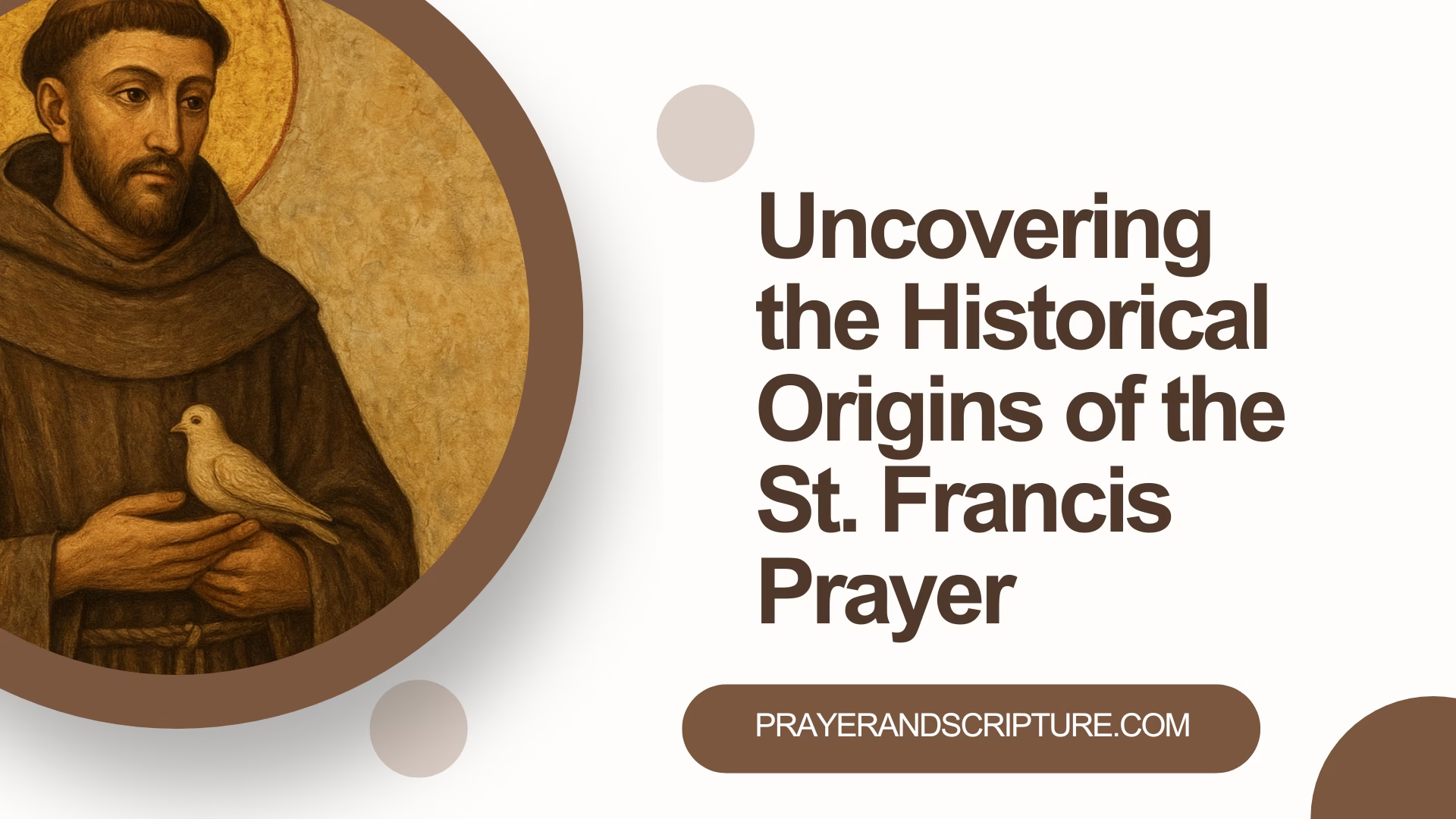
Contrary to popular belief, the origins of this prayer aren’t rooted in the medieval era of St. Francis of Assisi, but in the turbulent early 20th century. The first known appearance of the text was in 1912, published anonymously in a small French Catholic magazine called La Clochette (The Little Bell), which was associated with a devotional group known as La Ligue de la Sainte-Messe.
It was titled “Belle prière à faire pendant la Messe” (A Beautiful Prayer to Say During Mass) and was written in French, emphasizing peace amid the growing shadows of World War I. Europe was on the brink of catastrophe, with rising nationalism and militarism creating widespread anxiety. This prayer emerged as a quiet counterpoint, urging individuals to foster harmony in their immediate surroundings.
By 1916, it had spread to Italian publications, and during the war, it gained traction among soldiers and civilians alike as a symbol of hope. Its English translation appeared around 1927, often credited to an Anglican publication, but it really took off in the United States during the interwar period.
Cardinal Francis Spellman, a prominent American Catholic leader, distributed millions of copies to troops during World War II, associating it with St. Francis to evoke the saint’s legendary love for peace and nature. This wartime dissemination cemented its popularity, turning it into a global phenomenon. Post-war, it was embraced by the peace movement, recited at United Nations gatherings, and even featured in Alcoholics Anonymous literature as a tool for serenity and self-reflection.
What’s fascinating is how the prayer’s anonymity allowed it to evolve organically. Without a single author claiming credit, it became a collective expression of humanity’s yearning for tranquility. Scholars trace its style to earlier Christian writings, like those of St. Augustine or the Imitation of Christ by Thomas à Kempis, which emphasize humility and service. Yet, its modern phrasing—direct, accessible, and free of archaic language—made it perfect for the 20th century’s mass media age. In the 1960s, it inspired folk songs and hippie ideals, aligning with countercultural calls for love over war.
Today, in our digital era, it pops up on social media during crises, from pandemics to political unrest, proving its adaptability.
Exploring its history reveals not just a prayer, but a cultural artifact that mirrors society’s ongoing quest for peace amid perpetual conflict. It’s a testament to how words born in obscurity can ignite widespread inspiration, transcending their origins to touch souls worldwide.
Why the Prayer Isn’t Actually by St. Francis
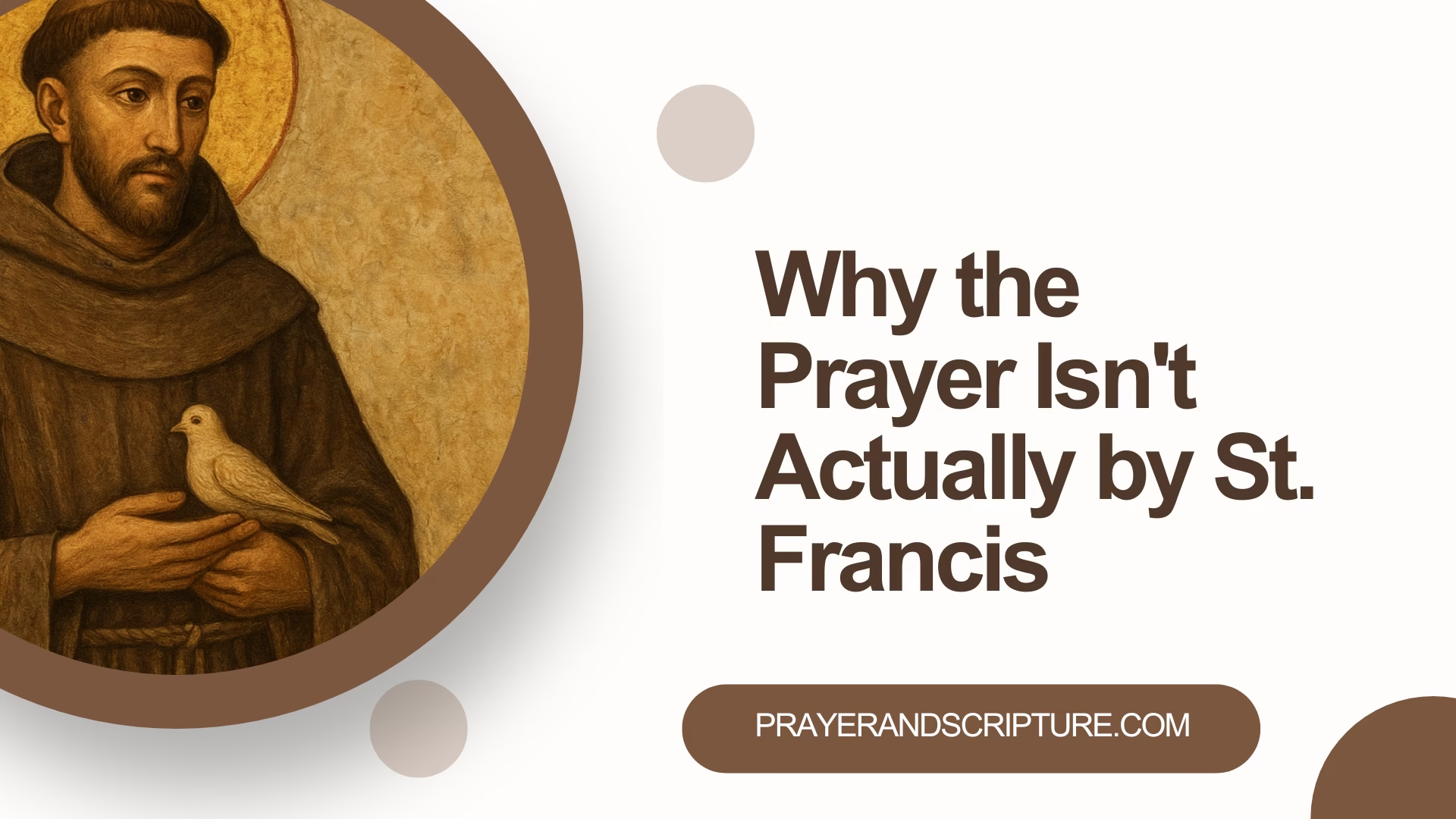
One of the most persistent misconceptions about this prayer is its attribution to St. Francis of Assisi, the 13th-century Italian friar known for his simplicity, love of animals, and devotion to poverty. While the prayer beautifully echoes Francis’s spirit—his Canticle of the Sun praises creation in a similar poetic vein—the historical evidence simply doesn’t support him as the author.
St. Francis lived from 1181 to 1226, a time of crusades and feudal strife, and his authentic writings, like the Rule of the Friars Minor or his Admonitions, focus on obedience, chastity, and evangelical living. Nowhere in his preserved texts does this specific prayer appear; instead, his prayers are more laudatory, praising God directly rather than petitioning for personal transformation in this exact way.
The mix-up likely started in the 1920s when a French Marquis, Stanislas de La Rochethulon, reprinted it on the back of a holy card featuring St. Francis, inadvertently linking the two. This association stuck because Francis embodies the ideals the prayer promotes: he famously brokered peace between warring cities, tamed a wolf in Gubbio through kindness, and preached to birds, symbolizing harmony with all creation.
During the world wars, attributing it to a saint added spiritual weight, making it more appealing for morale-boosting purposes. Franciscan scholars, including those at Franciscan Media, have long clarified this, noting that the prayer’s language and structure are distinctly modern, influenced by 19th-century piety rather than medieval Latin.
Debunking this doesn’t diminish the prayer’s value; if anything, it enhances it by highlighting its universal appeal. It shows how spiritual truths can be timeless, regardless of origin. Francis himself might have appreciated this, as he often downplayed personal acclaim, focusing on God’s glory. In today’s fact-checking culture, understanding this myth encourages deeper appreciation—it’s not about who wrote it, but how it resonates.
For believers, it’s a reminder that inspiration can come from anonymous sources, much like the unknown authors of many biblical psalms. This clarity invites us to engage with the prayer on its own merits, free from historical baggage, and to see St. Francis not as its creator, but as its perfect exemplar.
Line-by-Line Meaning and Interpretation of “Make Me an Instrument of Your Peace”
Let’s break this prayer down line by line, exploring the rich layers of meaning that make it so transformative. Starting with “Lord, make me an instrument of your peace,” we encounter a humble surrender. Here, the speaker isn’t demanding power but offering themselves as a tool—like a flute in a musician’s hands—to channel divine peace. Peace, or “shalom” in biblical terms, isn’t mere absence of conflict; it’s wholeness, harmony, and right relationships. In a world rife with division, this line challenges us to become active participants in healing, rather than passive observers.
Moving to “Where there is hatred, let me sow love; where there is injury, pardon,” the prayer shifts to practical action. Hatred is a seed that grows into violence, but sowing love counters it with empathy and forgiveness. Think of historical figures like Martin Luther King Jr., who echoed this in his nonviolent resistance. Injury could mean physical harm or emotional wounds; pardoning isn’t forgetting but releasing resentment to break cycles of revenge. This mirrors Jesus’s teachings in the Sermon on the Mount, urging love for enemies. In daily life, it might mean forgiving a colleague’s slight or responding to online trolls with kindness.
Next, “where there is doubt, faith; where there is despair, hope” addresses inner turmoil. Doubt erodes certainty, but faith—trust in something greater—rebuilds it. Despair is the loss of meaning, while hope is the light that persists. During personal crises, like illness or loss, this line inspires resilience, reminding us that faith isn’t blind optimism but a choice to believe in redemption.
Then, “where there is darkness, light; and where there is sadness, joy” evokes imagery of illumination. Darkness symbolizes ignorance or evil; light is truth and goodness. Sadness drains energy, but joy—deep, abiding gladness—restores it. This isn’t superficial happiness but a spiritual buoyancy, as seen in saints who found joy amid suffering.
The second stanza, “O Divine Master, grant that I may not so much seek to be consoled as to console; to be understood as to understand; to be loved as to love,” flips the script on selfishness. It’s a call to other-centeredness, inspired by Christ’s example of servant leadership. In relationships, this means listening first, empathizing before defending, and giving love without expecting reciprocation. Psychologically, it aligns with modern therapy’s emphasis on empathy, building stronger bonds.
Finally, “For it is in giving that we receive; it is in pardoning that we are pardoned; and it is in dying that we are born to eternal life” reveals profound paradoxes. Giving depletes yet fulfills; pardoning frees the forgiver; dying—whether to ego or literally—leads to rebirth. This echoes Gospel truths, like “lose your life to find it,” and has inspired movements from philanthropy to martyrdom.
Overall, the prayer isn’t just words—it’s a spiritual workout, training us in virtue through repetition and reflection. Each line invites introspection: Where am I sowing hatred instead of love? How can I console today? Interpreting it deeply transforms it from recitation to revolution, fostering personal and communal peace.
How the St. Francis Prayer Has Touched Lives Through History and Today
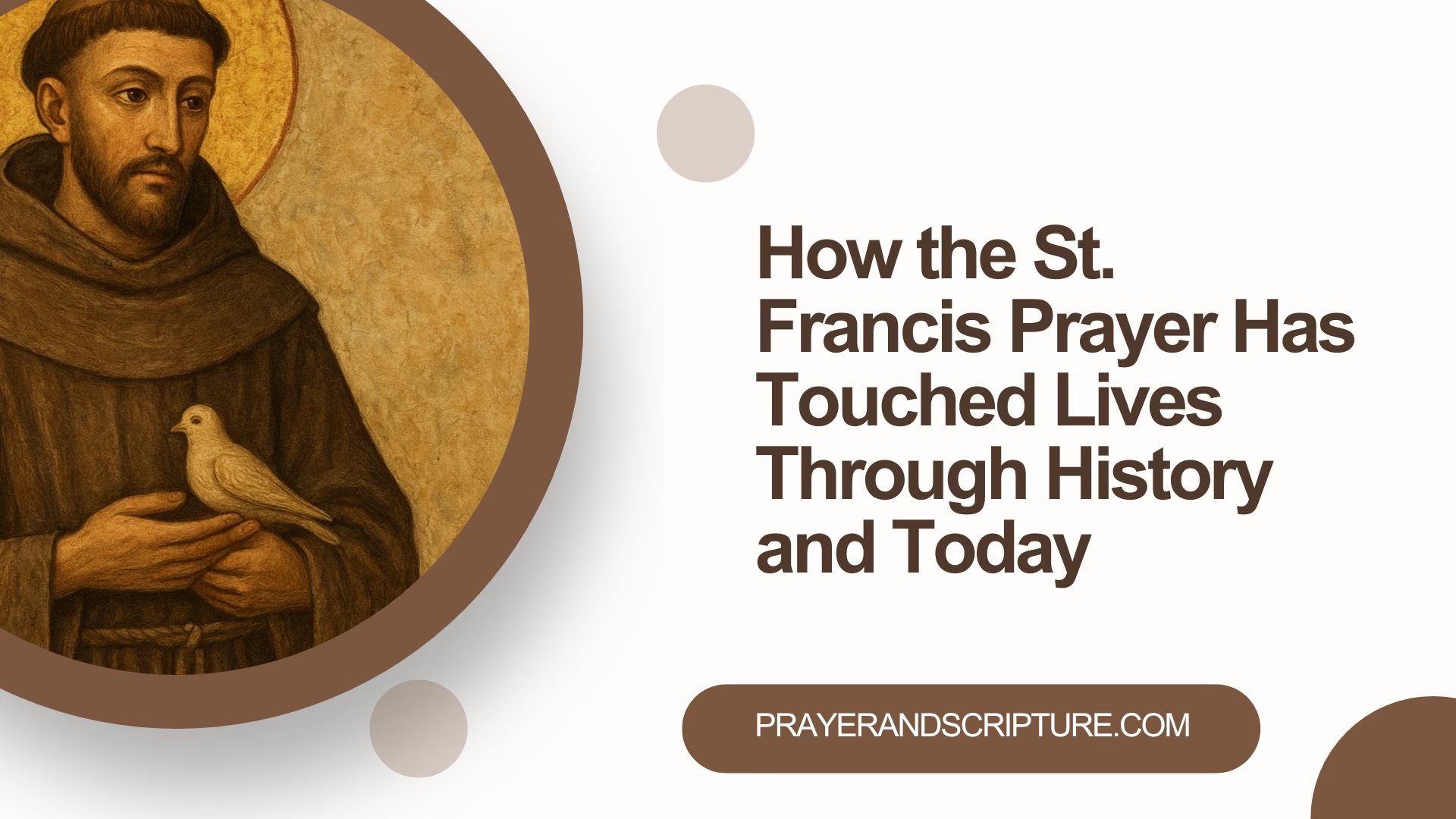
The St. Francis Prayer’s impact is best seen through stories of those who’ve lived it out, turning its words into action amid adversity. During World War II, Mother Teresa recited it while tending to the dying in Calcutta’s slums, embodying “where there is despair, hope” by founding the Missionaries of Charity. Her work, inspired by the prayer, brought light to forgotten souls, earning her a Nobel Peace Prize and sainthood. Similarly, in the civil rights era, Dr. King quoted it in speeches, using its call to sow love against hatred to fuel nonviolent protests that changed America.
In modern times, the prayer has surfaced in unexpected places. After the 9/11 attacks, it was read at Ground Zero memorials, consoling a grieving nation. Alcoholics Anonymous incorporates it into their 11th Step, helping members seek to understand rather than be understood, aiding recovery from addiction. One touching story comes from a nurse during the COVID-19 pandemic who whispered it over ventilated patients, finding strength to console families amid her own exhaustion.
On a personal level, consider the tale of a veteran struggling with PTSD who discovered the prayer in a support group. By focusing on pardoning injuries—both received and inflicted—he rebuilt relationships and found inner peace. Or the environmental activist who adapts it to advocate for nature, echoing St. Francis’s love for creation. Recently on social media, users share how reciting it during family conflicts sows love, turning arguments into understanding.
These stories illustrate the prayer’s versatility: it’s not confined to religious settings but inspires atheists, agnostics, and believers alike. In schools, teachers use it to teach empathy, reducing bullying. In prisons, inmates meditate on it for rehabilitation. Even celebrities like Oprah have referenced it for personal growth. What unites these narratives is transformation—from self-focus to service, hatred to healing. The prayer doesn’t promise easy fixes but offers a path through suffering, proving that one person’s commitment to peace can ripple outward, inspiring communities and generations.
Practical Ways to Incorporate the St. Francis Prayer into Your Daily Routine
Bringing the St. Francis Prayer into everyday life isn’t about grand gestures; it’s about small, intentional shifts that build habits of peace. Start your morning by reciting it during coffee or commute—let “make me an instrument” set your intention, turning routine into ritual. Journaling helps: after reading a line like “where there is hatred, let me sow love,” reflect on recent interactions and plan kinder responses.
In family life, make it a dinner table tradition, discussing how each member sowed hope that day. This fosters empathy, especially with kids learning emotional intelligence. At work, when conflicts arise, pause and mentally invoke “to be understood as to understand”—listen actively in meetings, diffusing tension.
For deeper integration, meditate on one line weekly: focus on “pardon” by forgiving a grudge, or “console” by calling a lonely friend. Apps with prayer reminders can help. In nature walks, channel St. Francis by appreciating creation while pondering the words. During stress, breathe through it: inhale “peace,” exhale “hatred.” Over time, this rewires reactions, making compassion automatic.
Community-wise, join groups reciting it, like church circles or online forums. Adapt for fitness: yoga poses with lines for mindfulness. The key is consistency—start small, and watch how it transforms mundane moments into opportunities for grace, leading to profound personal growth.
Exploring Variations and Adaptations of the St. Francis Prayer
The prayer’s simplicity has invited countless adaptations, evolving it for diverse audiences. The most famous is Sebastian Temple’s 1967 hymn “Make Me a Channel of Your Peace,” sung in churches worldwide, with a melody that enhances its meditative quality. Interfaith versions exist, like a Buddhist mantra: “May I be an instrument of peace,” blending with metta practices.
Modern rewrites update language: one contemporary take says “Creator, make me a tool of your harmony,” broadening appeal. Environmental adaptations add “where there is pollution, let me sow purity,” tying to ecology. In therapy, it’s reframed for self-healing: “Where there is self-hatred, let me sow self-love.” These variations keep it relevant, from pop songs to poetry, ensuring its message endures.
St Francis of Assisi Prayer for Animals
St. Francis of Assisi is widely known as the patron saint of animals and the environment. His love for all living creatures came from his deep belief that every part of creation reflects God’s beauty. While the “Prayer of St. Francis” does not explicitly mention animals, many Christians and pet lovers adapt its themes to bless and care for animals.
A typical St. Francis prayer for animals might say:
“Blessed are You, Lord God, for all the creatures You have made. Through St. Francis’ example, help us to treat them with kindness and protect them from harm. May we be instruments of Your peace to every living being.”
Churches often hold “Blessing of the Animals” ceremonies on October 4th (the feast of St. Francis), where this prayer is recited. Pet owners bring dogs, cats, birds, and even farm animals to receive a blessing.
The spirit of the prayer — bringing peace, love, and care — aligns perfectly with animal stewardship. Just as Francis saw birds, wolves, and lambs as “brothers and sisters,” we are called to respect animals as God’s creation.
In daily life, living out this prayer means adopting humane practices, supporting wildlife conservation, and showing compassion to creatures great and small. By doing so, we not only honor animals but also deepen our gratitude for the Creator who made them.
St Francis Prayer for Kids
The beauty of the “Prayer of St. Francis” is its adaptability for all ages — including children. A kid-friendly version simplifies the language while keeping its core message of kindness, forgiveness, and love. For example:
“Dear Lord,
Help me bring peace where there’s trouble,
Love where people are angry,
Kindness where there’s meanness,
Hope where people feel sad.
Help me forgive and share,
And remember that giving is better than getting.
Amen.”
Teaching children this prayer instills values of empathy, compassion, and humility. It becomes a gentle guide for their behavior in school, at home, and with friends. Parents and Sunday school teachers often use creative activities — like coloring pages, role-play, or song versions — to make the prayer memorable.
A children’s version can also connect with Bible stories that reflect the same values, such as the Good Samaritan, the Prodigal Son, and Jesus blessing the children. In this way, the prayer becomes not just words but a way of life.
Children who grow up with this prayer often carry its lessons into adulthood, making it a powerful seed of faith.
St Francis Prayer Instrument of Peace
The phrase “instrument of peace” is the most famous line from the Prayer of St. Francis, symbolizing the believer’s role as a vessel of God’s love in a hurting world. Being an instrument means actively allowing God to work through you — much like a musical instrument produces beauty only when in the hands of a skilled musician.
In practical life, being an “instrument of peace” could mean calming a heated argument, volunteering at a homeless shelter, forgiving someone who wronged you, or simply choosing patience over anger.
This concept is deeply scriptural, echoing Matthew 5:9: “Blessed are the peacemakers, for they shall be called children of God.” It challenges believers to replace negativity with Christ-like responses: love instead of hate, hope instead of despair, joy instead of sadness.
For St. Francis of Assisi, peace was not passive. It was active, intentional, and often sacrificial. Following his example means daily surrendering our will to God’s, asking Him to use us as a living channel of His grace.
St Francis Prayer AA
The “St. Francis Prayer” holds a special place in Alcoholics Anonymous (AA) meetings around the world. While not part of the original 12 Steps, many AA groups have embraced it as a spiritual meditation to inspire humility, service, and personal transformation. Often recited at the close of meetings, the prayer’s opening line — “Lord, make me an instrument of Your peace” — sets the tone for selflessness and a shift from self-centeredness to God-centered living.
AA members find the prayer helpful because it echoes the core AA principles of surrender, helping others, and living one day at a time. The lines “where there is hatred, let me sow love” and “where there is despair, hope” align closely with AA’s focus on repairing broken relationships and living with hope.
Spiritually, the prayer helps recovering alcoholics replace resentment with forgiveness, fear with faith, and self-pity with compassion. In AA circles, it is not just a prayer but a roadmap for daily living — encouraging service work, mentorship, and a new way of thinking.
Its message is universal, allowing members from various religious or non-religious backgrounds to embrace it. While called the “Prayer of St. Francis,” scholars note it first appeared in print in 1912 in France, decades before AA’s founding in 1935. Nevertheless, its spiritual depth has made it timeless.
In AA meetings, members may personalize the prayer: “Lord, make me an instrument of Your peace — especially with my family, my fellow members, and those I have hurt.” Many keep a copy in their Big Book or wallet as a reminder to respond with love instead of anger.
For AA members, this prayer is not about perfection but progress — walking in humility, showing kindness, and living in service, one day at a time.
Prayer of St Francis Lyrics
Though not originally a song, the “Prayer of St. Francis” has been set to music many times, making the term “lyrics” relevant. In church hymnals, it is often titled “Make Me a Channel of Your Peace” or simply “Prayer of St. Francis.” These musical versions are sung in Catholic, Anglican, Methodist, and non-denominational services worldwide.
The lyrics closely follow the original text of the prayer but may be adapted for rhythm and melody. For example, the hymn often starts:
Make me a channel of your peace,
Where there is hatred, let me bring your love…
Music adds a meditative, almost contemplative dimension to the prayer, allowing worshippers to internalize its message more deeply. Choirs, praise teams, and soloists have recorded versions in multiple languages, including Latin, Italian, French, and English.
The song is popular at weddings, funerals, ordinations, and peace vigils because it captures the heart of Christian service: bringing God’s love into the world through humble action. In schools, children often learn the sung version, helping them memorize the prayer effortlessly.
In modern worship, the “lyrics” concept expands to digital slideshows, YouTube videos, and worship streams where the prayer is displayed alongside instrumental music or nature scenes. This visual-lyrical combination helps the listener engage emotionally and spiritually.
By viewing the prayer as “lyrics,” we recognize its poetic rhythm and timeless beauty, making it not just a recitation but a song for the soul.
St Francis Prayer for Kids
The beauty of the “Prayer of St. Francis” is its adaptability for all ages — including children. A kid-friendly version simplifies the language while keeping its core message of kindness, forgiveness, and love. For example:
Dear Lord,
Help me bring peace where there’s trouble,
Love where people are angry,
Kindness where there’s meanness,
Hope where people feel sad.
Help me forgive and share,
And remember that giving is better than getting.
Amen.
Teaching children this prayer instills values of empathy, compassion, and humility. It becomes a gentle guide for their behavior in school, at home, and with friends. Parents and Sunday school teachers often use creative activities — like coloring pages, role-play, or song versions — to make the prayer memorable.
A children’s version can also connect with Bible stories that reflect the same values, such as the Good Samaritan, the Prodigal Son, and Jesus blessing the children. In this way, the prayer becomes not just words but a way of life.
Children who grow up with this prayer often carry its lessons into adulthood, making it a powerful seed of faith.
FAQs
1. What is the Prayer of St. Francis?
The Prayer of St. Francis, often beginning with “Lord, make me an instrument of your peace,” is a Christian prayer that encourages humility, love, forgiveness, and service to others. Although commonly attributed to St. Francis of Assisi, historians believe it originated in the early 20th century.
2. Why is the Prayer of St. Francis used in AA meetings?
Many Alcoholics Anonymous (AA) groups use the prayer because its message aligns with AA principles—selflessness, forgiveness, and spiritual growth. It serves as a reminder to live in peace and serve others one day at a time.
3. Is the Prayer of St. Francis in the Bible?
No, the Prayer of St. Francis is not found in the Bible. However, its themes closely mirror biblical teachings, especially passages about love, peace, and humility, such as Matthew 5:9 and Galatians 5:22–23.
4. Can I use the Prayer of St. Francis for children?
Yes. Many parents, teachers, and Sunday school leaders adapt the prayer into simpler language for kids, teaching values like kindness, forgiveness, and helping others.
5. Where can I get a printable PDF of the Prayer of St. Francis?
You can find free downloadable PDFs on many Christian websites or create your own by typing the prayer in a word processor and exporting it as a PDF. Some versions include decorative borders or images for a more beautiful presentation.
Conclusion
The St Francis Prayer Make Me An Instrument Of Your Peace is more than poetic words—it’s a daily invitation to embody the love and humility of Christ. It challenges us to turn away from selfish desires, to replace bitterness with forgiveness, and to shine light in the darkest places. In a world that often rewards pride, retaliation, and self-promotion, this prayer calls us to a higher path—the path Jesus walked, and the one St. Francis himself modeled through a life of simplicity, compassion, and peace-making.
If you pray these words sincerely, they will change not just your mindset, but the way you interact with the world. Every act of kindness, every moment of patience, every choice to love instead of hate becomes a note in the great symphony of God’s peace. May we not merely recite this prayer, but live it—until our lives themselves become the answer to someone else’s prayer for peace.
Also Read!
Catholic Prayer for Souls in Purgatory
Powerful St. Michael the Archangel Prayer for Courage And Protection
How to Pray to God: 7 Simple Steps to Start Today
Warfare Prayers To Destroy Setbacks, Poverty, And Failure
